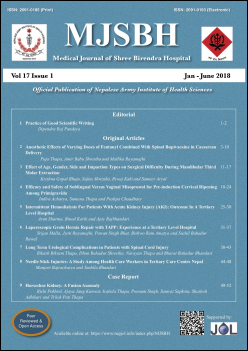Long term Urological complications in patients with Spinal cord injury
DOI:
https://doi.org/10.3126/mjsbh.v17i1.17732Keywords:
Neurogenic bladder, Spinal cord injury, Urinary tract infection, Nepal, ArmyAbstract
Introduction: Neurogenic bladder (NGB) is common in daily urological practice; however, information on types of urological complications encountered in army and veterans are not under strict surveillance and little is known to them about the best way to manage the condition. This observational study aimed to determine the types of urological complications encountered in regular soldiers and veterans with traumatic spinal cord injury (SCI) with NGB, and the usage of bladder management programs to deal with NGB.
Methods: We retrospectively reviewed the charts and records of interviewed patients with SCI in our urology clinic. Demographic data collected included: age, gender, mode of injury and level of spinal injury. Also noted were episodes of urinary tract infection (UTI), renal lesions, and bladder program followed.
Results: The mean age of our study sample (N= 63) was 40± 10.8 years and all were male. Age at onset of injury was 33.8 ± 16.6 years and duration since SCI insult was 90.6 ± 54 months. Symptomatic urinary tract infection (75%), chronic cystitis (53.3%), hydro-nephrosis (36.5%) and urinary bladder calculi (33.3%) were the common urological lesion observed. Indwelling Foley’s catheterization methods of urinary bladder management in 54% study population where urinary tract infection is more common (p<0.05).
Conclusion: Urinary tract infection, hydro-nephrosis and Urinary bladder calculi were the most common urological complications encountered in army and veterans with NGB. Indwelling Foley’s catheter was the most frequently used bladder management program with the higher risk for UTI.
Downloads
997
649




